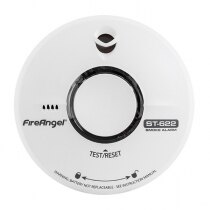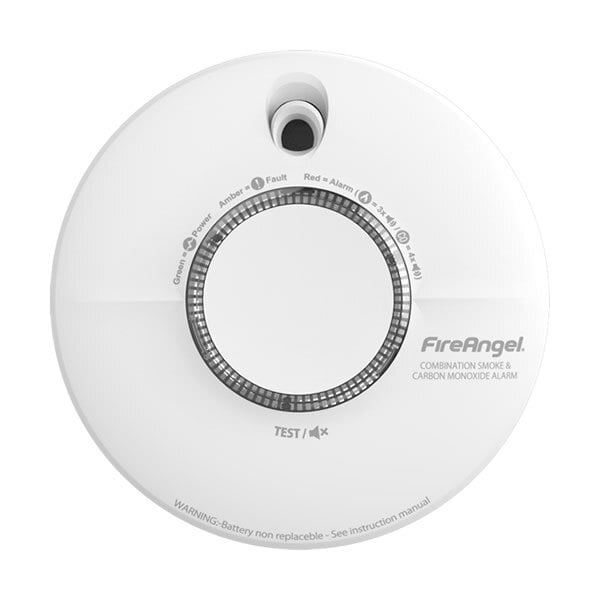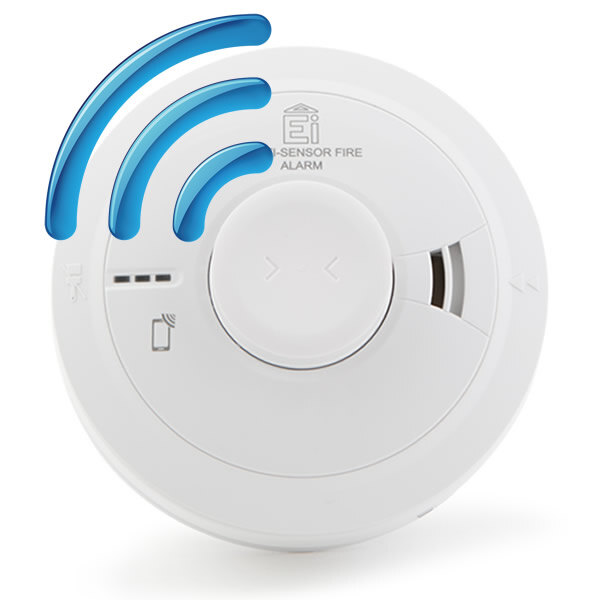-
Contact
Sales & Customer Service
0800 612 6537 support@safelincs.co.uk Live ChatDelivery Enquiries
0800 077 6149 - Resources
Fire & Safety Solutions
CALL OUR TEAM NOW 0800 612 6537
Lines open today 8am - 6pm
FREE Delivery
on marked products
Live Chat - Online
Instant help & Advice
Trade Discounts
and exclusive pricing
0% Credit Available
Open an account now
5 Star Customer Feedback
Combined Alarms with Multiple Sensors
Combined alarms contain multiple sensor types, including heat detection, optical smoke detection, and carbon monoxide detection. In this category, you will find a range of alarms with a number of variations, such as smoke & heat sensors, smoke & carbon monoxide detectors, and heat & CO alarms.
Generally, these types of alarms help to reduce the number of detectors required throughout your home, streamlining your weekly testing and end-of-life replacements. With the combination of multiple sensors in one alarm, detection technology becomes more advanced, reducing the risk of false alarms, or even increasing the speed that fire or carbon monoxide is detected.
Some versions of combined alarms are mains powered with a back-up battery, providing fire and CO coverage at all times. Additional capability of being hardwire interlinked, or even radio-interlink, provides the earliest possible warning to one or even two risks.
Combination Carbon Monoxide and Smoke Alarm 10 Yr Warranty - Kidde K10SCO
- Product Life: 10 years
- Battery: 2 x AA alkaline battery powered (included)
- Warranty: 10 year warranty
- Combined optical smoke and carbon monoxide detector
- Ideal for hallways, bedrooms, and living rooms
- Voice alarm and sounder: different warning messages for smoke and CO
- Certified to BS EN 14604: 2005 (smoke alarm)
- Certified to BS EN 50291-1: 2018 (CO alarm for domestic use)
10 Year Thermally Enhanced Optical Smoke Alarm (Thermoptek) - FireAngel ST-622
- Battery: Built-in, lasts the lifetime of your alarm
- Warranty: 5 year warranty
- Combined smoke and heat alarm (Thermoptek)
- Test, hush and Sleep Easy™ feature
- Optical sensor less prone to false alarms
- Suitable for BS 5839-6: 2019 (Grade F1 installations)
- Kitemarked to BS EN 14604:2005
10 Year Longlife Battery Combination Optical Smoke and CO Alarm - FireAngel SCB10-R
- Product Lifespan: 10 years
- Battery: Built-in, lasts the life time of your product
- Warranty: 5 year warranty
- Combined optical smoke and carbon monoxide detector
- Ideal for hallways, bedrooms and living areas
- Sleep Easy™ function
- Kitemarked to EN 14604: 2005 (smoke detection)
- Kitemarked to EN 50291-1 (carbon monoxide detection)
- Suitable for ceiling installation
Mains Powered Combined Optical Smoke and Heat Alarm with Self-Charging 10 Year Back-up Battery - Aico Ei3024
- Power: 230V mains powered with lifetime back-up battery
- Backup Battery: Self-charging battery
- Warranty: 5 year warranty
- Multi-sensor alarm containing both an optical and heat sensor
- Hardwire interlink with up to 12 compatible devices
- Extract real time data to your smart phone
- Kitemarked to BS EN 14604: 2005 (smoke)
- Kitemarked to BS 5446-2: 2003 (heat)
- Also suitable for both the Welsh and Scottish 2022 legislation
Mains Radio-Interlinked Combined Smoke and Heat Alarm with Self-Charging 10 Year Back-up Battery - Aico Ei3024RF
- Power: 230V mains powered with back-up battery
- Backup Battery: Self-charging battery
- Warranty: 5 year warranty
- Combined alarm: both an optical smoke, and heat sensor
- Hybrid interlinking with up to 12 compatible devices
- AudioLINK - extract real time data to your smart phone
- Kitemarked to BS EN 14604: 2005 (smoke)
- Kitemarked to BS 5446-2: 2003 (heat)
- Also suitable for both the Welsh and Scottish 2022 legislation
Replacement for FireAngel ST-620 10 Year Smoke Alarm - UltraFire ULLS10
- Easily replace FireAngel ST-620 alarm with UltraFire ULLS10
- Adaptor plate simply twists onto existing baseplate
- Battery: 10 year sealed lithium battery
- Warranty: 10 year manufacturer's warranty
- Combined test and silence button
- Suitable for BS 5839-6: 2019 Grade F1 installations
- CE and Kitemarked to BS EN 14604: 2005
Mains Powered Heat & CO Detector with Rechargeable Lithium Battery Backup - Hispec RF10-PRO
- Power: 230V mains powered with lithium back-up battery
- Back-up Battery: Rechargeable lithium battery
- Warranty: 5 year manufacturer's warranty
- Multi-sensor alarm containing both an heat and CO sensor
- Radio-interlink up to 20 compatible alarms
- Kitemarked to BS 5446-2: 2003 (heat)
- Kitemarked to BS EN 50291-1: 2018 (carbon monoxide)
- Also suitable for both the Welsh and Scottish 2022 legislation
Mains Powered Smoke & Heat Alarm with Rechargeable Lithium Battery Backup - Hispec RF10-PRO
- Power: 230V mains powered with lithium back-up battery
- Back-up Battery: Rechargeable lithium battery
- Warranty: 5 year manufacturer's warranty
- Multi-sensor alarm containing both a smoke and heat sensor
- Radio-interlink up to 20 compatible alarms
- Kitemarked to BS EN 14604: 2005 (smoke)
- Kitemarked to BS 5446-2: 2003 (heat)
- Also suitable for both the Welsh and Scottish 2022 legislation
Combination Carbon Monoxide and Smoke Alarm 10 Yr Warranty - Kidde 10SCO
- Product Lifespan: 10 years
- Battery: 2 x AA alkaline batteries (included)
- Warranty: 10 year warranty
- Voice Alarm and Sounder: Different Warning Messages for Smoke and CO
- Kitemarked to BS EN 50291-1: 2018 (CO alarm for domestic use)
- Kitemarked to BS EN 14604: 2005 (smoke alarm)
- Suitable for ceiling installation
4.8 out of 5 stars
View Product
| 1 unit |
£21.90 inc VAT £18.25 ex VAT |
|---|---|
| 2+ units |
£21.30 inc VAT £17.75 ex VAT |
| 5+ units |
£20.10 inc VAT £16.75 ex VAT |
Combined Alarms with Multiple Sensors
Improving Fire & CO Detection in my Home
Combined Alarms with Multiple Sensors
Combined alarms provide additional smoke, heat, and carbon monoxide detection through multiple sensors. These combination alarms usually have different alarm sounds, especially when detecting for two different dangers such as fire and carbon monoxide (including voice alert warnings) to inform occupants of the type of danger that has been detected. Combined sensor alarms are available in a range of configurations, including:
- Optical smoke detectors with heat detection
- Optical smoke detectors with carbon monoxide (CO) detection
- Heat detectors with carbon monoxide (CO) detection
Different combined sensor alarms are best suited to different areas of the home. For example, heat and CO alarms are great for kitchens and garages, reducing false alarms from dust and steam which may trigger optical alarms, while providing carbon monoxide detection. Smoke and heat detectors are suitable for kitchen diner rooms (but not directly over the kitchen area) where no fuel burning appliance is installed, while smoke and CO alarms are suitable throughout the home, apart from in kitchens, garages, and unoccupied loft spaces.
Combination alarms are also available in battery powered and mains powered variants, with radio-interlink technology and hard-wire options. This allows combined alarms to fulfil the highest levels of home protection. If you’re struggling to find the best detector for your needs, use our handy filter system for this category page, or contact our friendly customer support team on 0800 612 6537 for further advice.
Improving Fire & CO Detection in my Home
There are lots of things you can do to improve fire safety in your house. Fitting working smoke and heat alarms throughout your home is the best way to protect your family, while testing these regularly is just as important. Installing combination alarms which includes carbon monoxide detection further protects your family from dangers within the home.
Other steps to prevent fires, amd slow the spread of fire if one does start can also keep your family safe. For example, by keeping doors shut at night, even if they are not fire doors, they will act as a barrier to slow the spread of flames throughout the home by a few minutes, increasing time for your family to safely escape. This is particularly important for doors providing access to the kitchen, as this is where fires are most likely to start.
The best way to prevent fires in the home is to be aware of fire risks, and to reduce these wherever possible. For example, homes which are particularly cluttered, have deep fat fryers, or where residents smoke have an increased fire risk. To find out more about the fire risks in your home, use our Home Fire Safety Check tool. This quick questionnaire will identify the fire risks in your home, and give personalised tips on improving fire safety.
Compare (0)
Reset



























